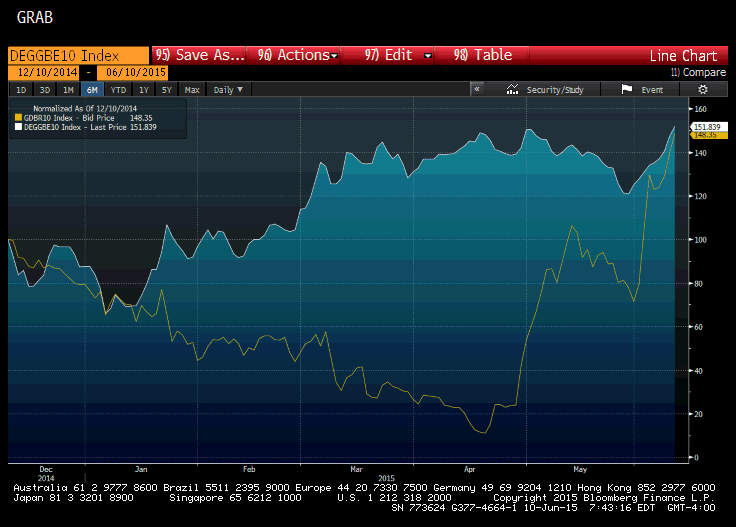The dramatic sell-off in German bunds caught many investors off guard. The conventional wisdom, for which we too were sympathetic, was that there was going to be a shortage of bunds.
The Grand Coalition led by Chancellor Merkel is not only committed to a balance budget this year, but it will also retire some debt. These policies limit supply at the same time that the ECB's bond buying program increases demand. In addition, bunds are used not only for investment but collateral.
The German 10-year yield fell around 56 bp at the end of last year to about 5 bp in mid-April. It has since risen sharply. The first leg carried it to about 80 bp into early May. It consolidated for a couple of weeks, and since the start of the month, taken another step up.Today the yield reached almost 1.06%. This is depicted by the yellow line in this Great Graphic created on Bloomberg. From a chart-based perspective, the next target is near 1.25%.

A key question is why are the bunds selling off. There is much to be said for market positioning and the lack of liquidity. Long, and even overweight bunds, was a favorite position for real and leveraged fund managers. It also was a defensive position in case of Grexit or worse. The lack of liquidity is often attributed to official action in the form of QE, but also the greater regulatory environment. In addition, we would include technological developments, which have also served to fragment the market.
There is another factor that few accounts incorporate. Inflation expectations have risen. Inflation in the eurozone has been trending lower.The drop in oil prices was an additional force that weighed on headline inflation, which is what the ECB targets. Indeed, it was precisely risk of deflation that prompted the ECB to announce an asset purchase plan over the objection of Germany, though it has not stopped observers from arguing that Germany drives EMU monetary policy.
Deflation, as measured by a year-over-year decline in headline CPI did materialize. CPI in the euro area was negative from December through March. It bottomed at -0.6% in January. It was flat in April and rose to 0.3% in May.The bund yield bottomed when it became clear to investors that the downside risks of deflation were subsiding, helped in part by the recovery of oil prices and the stronger eurozone economy in general.
The white line in the chart shows the 10-year German breakeven. This is the interest rate differential between the conventional yielding bund and the inflation-linked bund.This is a market-based measure for inflation expectations.What the chart shows is that inflation expectations were rising in Q1 even as bund yields fell.
The 10-year breakeven rose from 59 bp in early January to 1.29% in late March. Bund yields fell by about 45 bp over that period. The breakeven rose to 1.33% on the day that the 10-year bund yield recorded its low near 5 bp (April 17). Today it reached 1.38%, the highest since last August.
This means year-to-date, the 10-year breakeven has risen by about 60 bp while the bund yield has risen by about 50 bp. Liquidity is an important caveat. If the liquidity of conventional bunds is problematic, it is even more true of the inflation-linked bunds.
The euro and 10-year bund moved in the same direction about 83% of the time over the last 50 sessions. This is just off the peak set in February (95%). As bund yields were falling so was the euro in much of Q1.That correlation has been fairly stable this year. The implication is clear. If you are trading the euro keep an eye on German bunds. Selling of German bunds (higher yields) at the same time as the euro appreciates.US economic data is of secondary importance in this environment.
